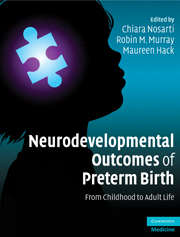Book contents
- Frontmatter
- Contents
- List of contributors
- Preface
- Section 1 Introduction
- 1 Epidemiology of preterm birth
- 2 The changing face of intensive care for preterm newborns
- 3 Clinical outcome: neurological sequelae following preterm birth
- Section 2 Neuroimaging
- Section 3 Behavioral outcome
- Section 4 Neuropsychological outcome
- Section 5 Applied research
- Section 6 Conclusions
- Index
3 - Clinical outcome: neurological sequelae following preterm birth
from Section 1 - Introduction
Published online by Cambridge University Press: 06 July 2010
- Frontmatter
- Contents
- List of contributors
- Preface
- Section 1 Introduction
- 1 Epidemiology of preterm birth
- 2 The changing face of intensive care for preterm newborns
- 3 Clinical outcome: neurological sequelae following preterm birth
- Section 2 Neuroimaging
- Section 3 Behavioral outcome
- Section 4 Neuropsychological outcome
- Section 5 Applied research
- Section 6 Conclusions
- Index
Summary
Introduction
Neurological outcome after preterm birth refers to neurologically defined conditions due to disorders of the motor system – e.g. spasticity, dyskinesia or ataxia – which are commonly summarized under the term “cerebral palsy” (CP). Studies of CP in relation to birth weight (BW) and gestational age (GA) estimate that infants of very low birth weight (VLBW); i.e., of BW less than 1500 g, or very immature infants; i.e., with GA less than 32 weeks, are between 40 and 100 times more likely to have CP than normal BW infants or infants born at term [1, 2]. No other disability associated with preterm birth, such as learning impairments, mental retardation, behavioral problems or sensorineural deficits, shows such a high difference in prevalence in relation to birth at term or normal BW. This means that CP following preterm birth, or brain compromise affecting the motor system, is probably related to a pathomechanism specifically affecting the immature brain, which stresses the importance of gaining insight into the following questions:
What is the prevalence of CP following preterm birth with respect to mortality and during the course of development? A hypothesis suggests that increasing survival rates are associated with increasing CP rates as more preexistingly damaged children are brought to survival. The competing hypothesis assumes that increasing survival rates first lead to increasing, but then to decreasing or at least stable CP rates, as progress in pre-, peri-, and neonatal care first reduces mortality, and subsequently also morbidity.
[…]
- Type
- Chapter
- Information
- Neurodevelopmental Outcomes of Preterm BirthFrom Childhood to Adult Life, pp. 30 - 38Publisher: Cambridge University PressPrint publication year: 2010
- 2
- Cited by



